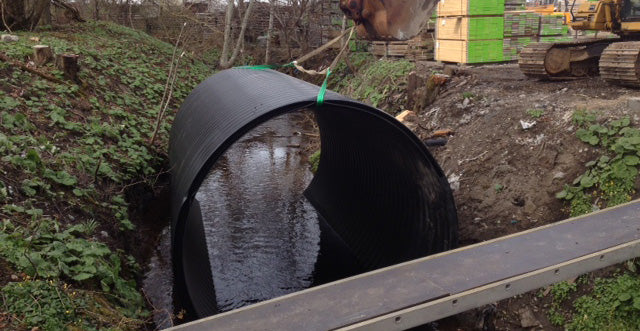Culvert Installment Facilitated: Step-by-Step Overview for Success
Setting up culverts might appear like an uncomplicated task, however making certain an effective end result requires cautious preparation and implementation. From selecting the ideal culvert size to incorporating correct drainage procedures, each step in the installment procedure plays an important function in the capability and durability of the culvert system. By adhering to a systematic technique and focusing on vital details, the installment can proceed smoothly, reducing possible problems down the line. Keep tuned to reveal the essential actions and considerations that can make culvert setup a smooth and successful endeavor.
Selecting the Right Culvert Size
Selecting the appropriate culvert dimension is crucial for guaranteeing effective water circulation and structural integrity in culvert installation tasks - Pad Construction. The dimension of the culvert directly affects the flow ability of water via the framework. A culvert that is as well little can bring about flooding and overflow, while one that is as well big might lead to reduced water speed, potentially causing debris buildup and blockages
To establish the best culvert dimension, variables such as the watershed location, peak circulation rates, and hydraulic performance need to be very carefully thought about. Computations based on these parameters assist in picking a dimension that can appropriately deal with the anticipated water volume while minimizing the danger of clogs and architectural failing.
It is necessary to consult design standards and criteria to guarantee that the selected culvert dimension meets the task demands and regional policies (Pad Construction). By picking the ideal culvert size, project managers can enhance water flow, prevent possible concerns, and boost the total performance and durability of the culvert installation
Preparing the Installment Site
Effective culvert setup necessitates thorough prep work of the installment site to make sure optimum structural support and performance. Prior to beginning the installment process, it is vital to get rid of the website of any debris, plant life, or blockages that could hamper the culvert's placement. Making certain a degree foundation is crucial for the proper alignment and stability of the culvert. This might involve grading the website to develop a smooth, even surface that can sufficiently sustain the weight of the culvert and any awaited tons. Additionally, appropriate compaction of the soil under the culvert is essential to prevent working out or changing with time.
Additionally, it is very important to take into consideration variables such as soil make-up, groundwater levels, and ecological influences check my blog when preparing the installment site. Carrying out an extensive website analysis can assist recognize any kind of possible challenges or risks that may affect the culvert's performance. By taking the time to prepare the installation website properly, you can aid ensure a successful culvert installment that satisfies structural demands and makes certain long-lasting functionality.
Placing the Culvert Correctly

The quality at which the culvert is placed is important for preserving a proper incline for water circulation. A steady slope aids prevent pooling and advertises effective drainage. Additionally, the culvert should be oriented appropriately to ensure that the inlet and outlet remain in the correct places. This alignment is important for the culvert to function efficiently in handling water circulation.
Backfilling and Condensing the Dirt
Proper backfilling and compaction of the dirt around the culvert is necessary to ensure security and prevent possible problems in the future. When the culvert is correctly positioned, the next crucial step is to backfill the area around it with ideal product. The backfill product must be devoid of rocks, particles, and natural matter to avoid damage to the culvert. It is suggested to make use of granular material such as sand or gravel for backfilling, as it offers great drain and compaction homes.
After putting the backfill product, it is important to small it in layers of consistent thickness. Making use of a compactor or a mechanical meddle, compact the dirt carefully to avoid damaging like this the culvert. Compaction aids in decreasing the chances of settlement and makes certain uniform support around the culvert. It is crucial to small the soil equally on all sides of the culvert to maintain its structural integrity.
Appropriate backfilling and compaction not just provide security to the culvert yet also aid in protecting against soil erosion and preserving the durability of the culvert system.
Guaranteeing Proper Drainage Assimilation
Incorporating efficient water drainage services plays a vital role in the overall capability and durability of culvert installments. Appropriate drainage integration is essential for managing water circulation, stopping disintegration, and making sure the architectural stability of the culvert system. To achieve this, it is important to make a detailed drainage plan that thinks about aspects such as the quantity of water anticipated, the topography of the location, and the kind of soil present.

Additionally, including attributes like erosion control actions, such as riprap or vegetation, can further enhance the performance of the water drainage system. By thoroughly intending and implementing these drain remedies, culvert setups can function efficiently and withstand the test of time.
Final Thought
To conclude, proper culvert setup is crucial for keeping reliable water drainage systems. By picking the appropriate culvert dimension, preparing the setup site, putting the culvert properly, backfilling and compacting the soil, and guaranteeing appropriate drainage combination, success can be accomplished. Following these actions will certainly assist ensure the durability and performance of the culvert, inevitably adding to the overall success of the drain system.